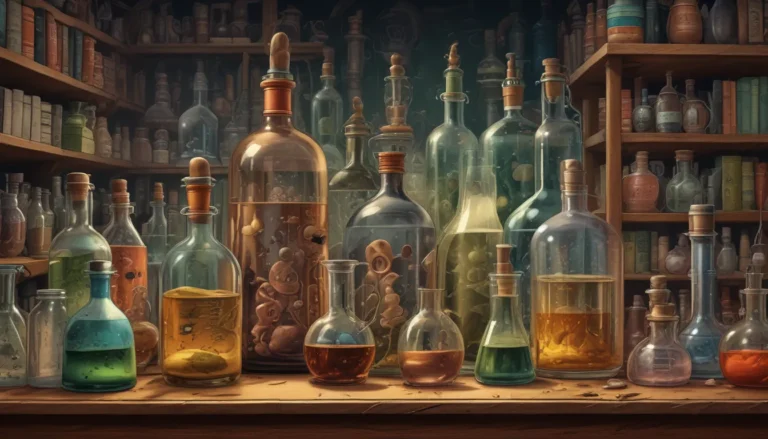A Note About Images: The images used in our articles are for illustration purposes only and may not exactly match the content. They are meant to engage readers, but the text should be relied upon for accurate information.
Are you curious about the world of pH and how it impacts everything from what we eat to the products we use? pH, short for potential of hydrogen, is a critical measurement scale that determines the acidity or alkalinity of a solution. From everyday household items to complex chemical reactions, pH plays a significant role in various fields, including chemistry, biology, and environmental science.
In this article, we will delve into 11 astounding facts about pH that will broaden your knowledge and appreciation for this fundamental concept. From the basics of pH measurement to its applications in preserving food and maintaining healthy teeth, these facts will provide you with valuable insights into the importance of pH in our daily lives.
So, grab your lab coat and get ready to explore the captivating world of pH!
Key Takeaways:
- Understanding pH is crucial as it impacts everything from the water we drink to the plants we grow. Maintaining the right pH levels is essential for our health, environment, and overall well-being.
- From the acidity of lemon juice to the alkalinity of baking soda, pH influences a wide range of substances and biological systems.
The Meaning of pH
pH stands for “potential of hydrogen” and represents the concentration of hydrogen ions in a solution. It is a logarithmic scale ranging from 0 to 14, with 7 considered neutral.
pH and Acidity
A substance with a pH value of less than 7 is considered acidic. The lower the pH number, the higher the acidity. For example, lemon juice has a pH of around 2, making it highly acidic.
pH and Alkalinity
Substances with a pH greater than 7 are considered alkaline or basic. Baking soda, with a pH of around 9, is an example of an alkaline substance.
The pH of Water
Pure water has a pH of 7, which is considered neutral. However, the pH of water can vary depending on factors such as minerals and pollutants present in the water.
pH and Biological Systems
Living organisms, including humans, have specific pH requirements to maintain optimal functioning. For example, the pH of human blood is tightly regulated at around 7.4.
Acid Rain
Acid rain, characterized by a pH value below 5.6, is caused by emissions of sulfur dioxide and nitrogen oxide from industrial activities and vehicle emissions.
pH in Food Preservation
pH plays a crucial role in food preservation. Foods with lower pH levels, such as pickles and jams, create an environment that inhibits the growth of bacteria and other microorganisms.
pH in Swimming Pools
Maintaining the pH level between 7.2 and 7.8 in swimming pools is essential for optimal disinfection and to prevent skin and eye irritations.
pH and Tooth Decay
Acidic foods and drinks can erode tooth enamel, leading to tooth decay. Monitoring the pH of oral care products and reducing acidic food consumption helps maintain healthy teeth.
pH in Cosmetics
pH balance is crucial in skincare and cosmetic products. Products with a pH close to the skin’s natural pH level (around 5.5) are considered gentle and less likely to cause irritation.
pH in Soil
Soil pH affects plant growth and nutrient availability. Understanding the pH preferences of different plants helps optimize their growth in various environments.
Understanding the significance of pH in various aspects of life empowers us to make informed decisions about our health, environment, and everyday choices. The 11 fascinating facts about pH highlight its importance in multiple fields and emphasize the need for pH balance in different applications.
Conclusion
Exploring the world of pH opens up a realm of knowledge that applies to everyone, whether you’re a student, scientist, or simply curious about the world around you. These 11 fascinating facts about pH shed light on the significance of this scale in various aspects of our lives. From the importance of maintaining proper pH levels in our bodies to the ways pH affects the environment, these facts showcase how pH impacts everything from everyday household items to complex chemical reactions.
By understanding pH and its implications, we can make informed decisions that contribute to our well-being and the health of our planet. Dive into the world of pH, deepen your knowledge of this essential concept, and discover how pH influences every aspect of our lives.
FAQs
- What does pH stand for?
-
pH stands for “potential of hydrogen.”
-
How does pH indicate acidity or alkalinity?
-
pH values below 7 indicate acidity, while values above 7 indicate alkalinity. A pH of 7 is considered neutral.
-
Why is maintaining the pH balance important?
-
Maintaining the pH balance is crucial for enzyme function, environmental preservation, and the regulation of bacterial growth.
-
How does pH affect our bodies?
-
pH levels impact bodily functions, including digestion, circulation, and organ function. Imbalances in pH can lead to health issues.
-
What are some common examples of pH in everyday life?
-
Examples of pH in everyday life include beverages, cleaning products, and skincare items that have varying pH levels.
-
How is pH measured?
-
pH is measured using indicators, pH meters, or litmus paper to determine the concentration of hydrogen ions in a solution.
-
What is the pH level of pure water?
-
The pH level of pure water is 7, indicating neutrality.
-
Can pH affect plant growth?
-
Yes, pH levels in soil impact nutrient availability for plants, influencing their growth.
-
Can pH values be negative or higher than 14?
-
No, pH values range from 0 to 14, with negative values or values above 14 not possible.
-
Can pH levels be changed?
- pH levels can be altered by adding acidic or alkaline substances to a solution.
-
Are there any natural substances with extreme pH levels?
- Some natural substances, like gastric acid in the stomach and lye, have extreme pH levels that are essential for specific functions.
Explore the world of pH, unravel its mysteries, and embrace the knowledge that empowers you to make informed decisions about your health, environment, and everyday choices. Dive into the fascinating realm of pH and discover the wonders of this essential concept!






